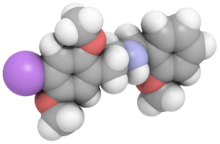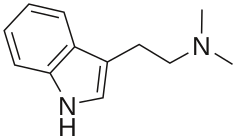 | |
 | |
| Clinical data | |
|---|---|
| Other names | 2C-I-NBOMe; 25I; N-Bomb; Smiles; Wizard |
| Routes of administration | Buccal (sublabial), sublingual, insufflated, inhalation, intravenous, intramuscular, rectal |
| ATC code |
|
| Legal status | |
| Legal status |
|
| Pharmacokinetic data | |
| Metabolism | Extensive first-pass metabolism in the liver |
| Elimination half-life | Unknown |
| Excretion | Urine |
| Identifiers | |
| |
| CAS Number | |
| PubChem CID | |
| ChemSpider | |
| UNII | |
| KEGG | |
| ChEMBL | |
| CompTox Dashboard (EPA) | |
| Chemical and physical data | |
| Formula | C18H22INO3 |
| Molar mass | 427.282 g·mol−1 |
| 3D model (JSmol) | |
| |
| |
| | |
| Part of a series on |
| Psychedelia |
|---|
 |
25I-NBOMe (2C-I-NBOMe, Cimbi-5, and also shortened to "25I"), also known as Smiles, or N-Bomb, is a novel synthetic psychoactive substance with strong hallucinogenic properties, synthesized in 2003 for research purposes. Since 2010, it has circulated in the recreational drug scene, often misrepresented as LSD.
25I was synthesized for biochemistry research to map the brain's usage of the type 2A serotonin receptor. A derivative of the substituted phenethylamine 2C-I family, it is the most well-known member of the 25-NB family. It was discovered in 2003 by chemist Ralf Heim at the Free University of Berlin, who published his findings in his PhD dissertation.[5] The compound was subsequently investigated by a team at Purdue University led by David Nichols.[6]
The carbon-11 labelled version of 25I-NBOMe, [11C]Cimbi-5, was synthesized and validated as a radiotracer for positron emission tomography (PET) in Copenhagen.[7][8] Being the first 5-HT2A receptor full agonist PET radioligand, [11C]CIMBI-5 shows promise as a more functional marker of these receptors, particularly in their high affinity states.[7]
Street and media nicknames for this drug are: "N-Bomb", "Solaris", "Smiles", and "Wizard", although the drug is frequently fraudulently sold as LSD.[9][10][11]
Due to its physical effects and risk of overdose, there have been multiple deaths attributed to the drug. Its long term toxicity is unknown due to lack of existing research.
- ^ Anvisa (2023-07-24). "RDC Nº 804 - Listas de Substâncias Entorpecentes, Psicotrópicas, Precursoras e Outras sob Controle Especial" [Collegiate Board Resolution No. 804 - Lists of Narcotic, Psychotropic, Precursor, and Other Substances under Special Control] (in Brazilian Portuguese). Diário Oficial da União (published 2023-07-25). Archived from the original on 2023-08-27. Retrieved 2023-08-27.
- ^ "Regulations Amending the Food and Drug Regulations (Part J — 2C-phenethylamines)". Canada Gazette. 4 May 2016. Archived from the original on 2016-08-31. Retrieved 2016-08-22.
- ^ UK Home Office (2014). "The Misuse of Drugs Act 1971 (Ketamine etc.) (Amendment) Order 2014". UK Government. Archived from the original on 2014-12-04. Retrieved 2014-03-11.
- ^ "Substance Details 25I-NBOMe". Archived from the original on 2024-01-23. Retrieved 2024-01-23.
- ^ Heim R (25 March 2003). "Synthese und Pharmakologie potenter 5-HT2A-Rezeptoragonisten mit N-2-Methoxybenzyl-Partialstruktur. Entwicklung eines neuen Struktur-Wirkungskonzepts" (in German). diss.fu-berlin.de. Archived from the original on 2012-04-16. Retrieved 2013-05-10.
- ^ Braden MR (2007). "Towards a biophysical understanding of hallucinogen action". Dissertation. Purdue University: 1–176. Archived from the original on 2016-09-19. Retrieved 2016-07-19.
- ^ a b Ettrup A, Palner M, Gillings N, Santini MA, Hansen M, Kornum BR, et al. (November 2010). "Radiosynthesis and evaluation of 11C-CIMBI-5 as a 5-HT2A receptor agonist radioligand for PET". Journal of Nuclear Medicine. 51 (11): 1763–1770. doi:10.2967/jnumed.109.074021. PMID 20956470.
- ^ Hansen M (16 December 2010). "Design and synthesis of selective serotonin receptor agonists for positron emission tomography imaging of the brain". Ph.D. Thesis. Det Farmaceutiske Fakultet, København. CiteSeerX 10.1.1.690.4529.
- ^ "Erowid 25I-NBOMe Vault". Archived from the original on 2016-06-30. Retrieved 2016-06-28.
- ^ Vanderbilt University Medical Center (9 April 2015). "Poison center warns against designer drug 'N-bomb'". ScienceDaily. Archived from the original on 9 May 2016. Retrieved 14 April 2016.
- ^ Mackin, Teresa (October 9, 2012). Dangerous synthetic drug making its way across the country. Archived October 31, 2012, at the Wayback Machine WISH-TV